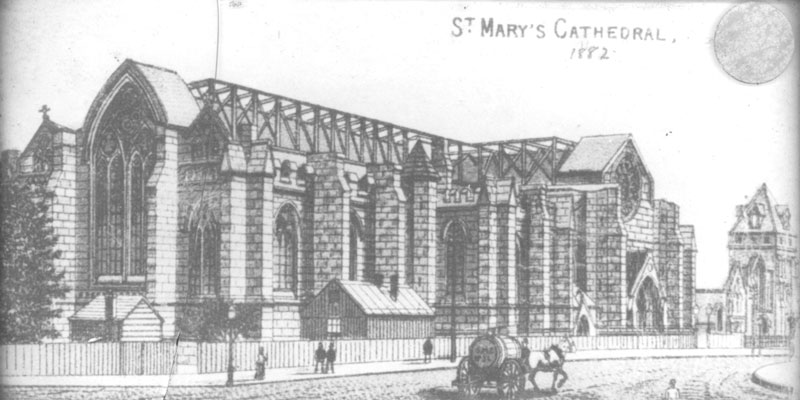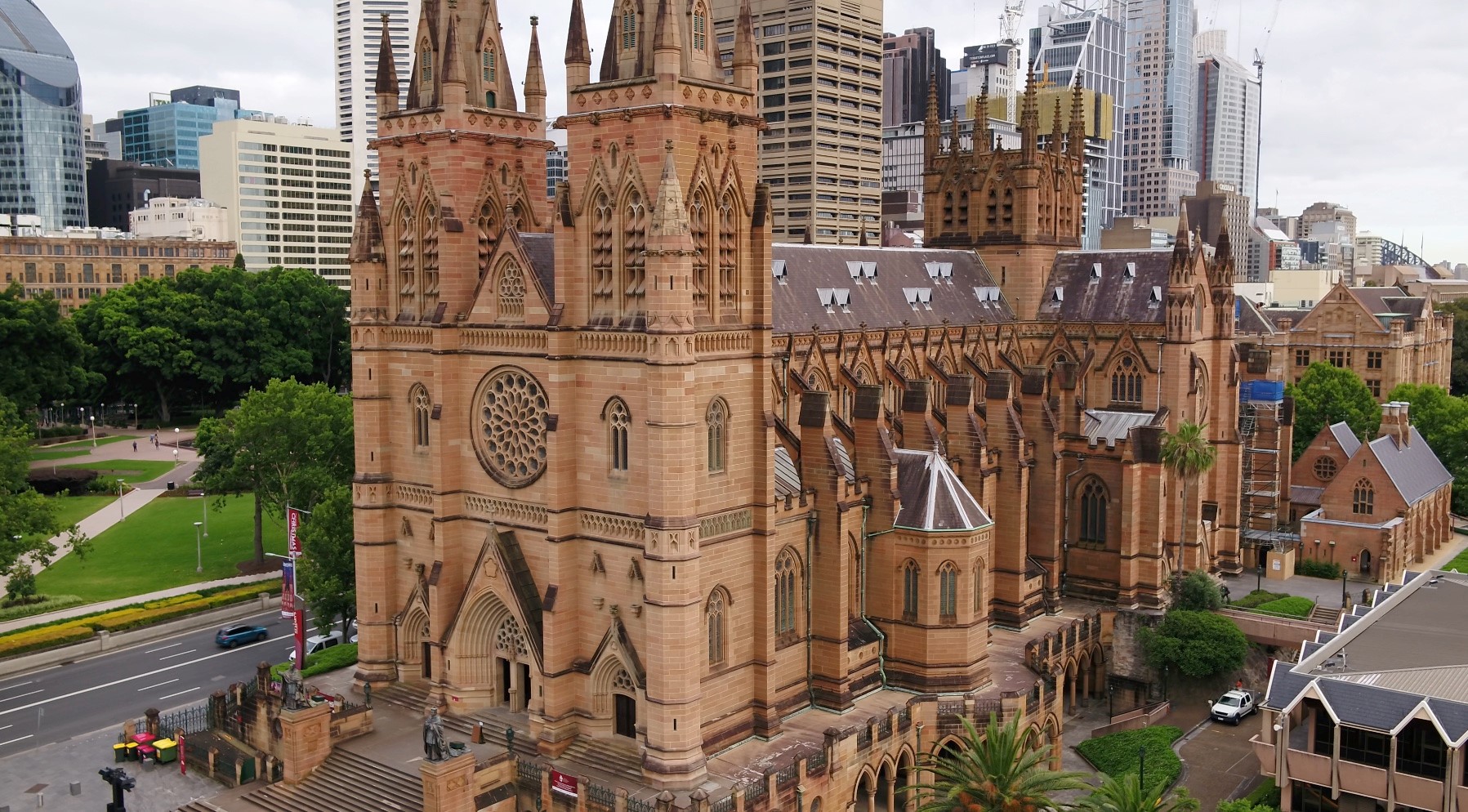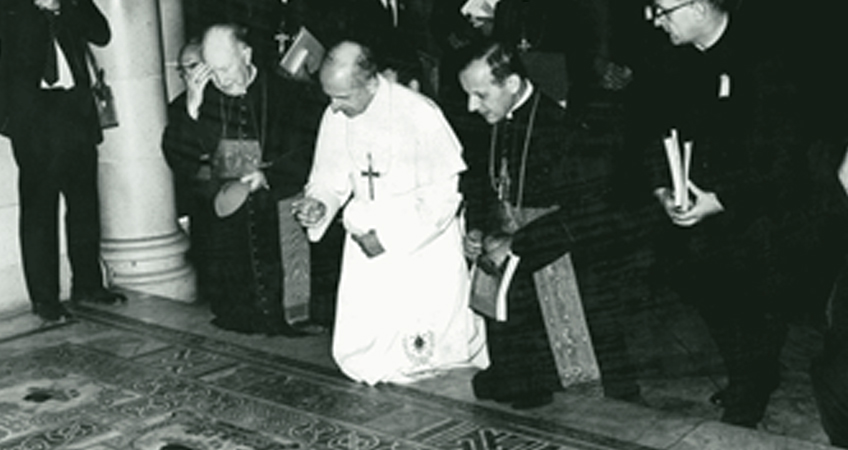Walking Down 200 Years Memory Lane
St Mary’s Cathedral is Australia’s largest cathedral. It is one of Sydney’s most treasured historic buildings and one of the finest examples of English-style gothic churches in the world.
Old and New St Mary’s have been visited by millions of faithful, tourists, and so far four canonized saints. It is an eloquent proclamation in stone of the Christian faith, a centre of prayer and worship, a peaceful refuge in a bustling city, and the jumping off point for the great mission to this continent.
Generations of artists have bequeathed to it their magnificent gifts in stone and glass, designing a unique space of solace and prayer within this vibrant city. It is regarded as the Mother Church of Australian Catholics, and stands on the first Catholic Chapel in Australia. It is the spiritual home of Sydney’s Catholics, and the seat of the Archbishop of Sydney. The Cathedral is officially dedicated to Mary, Help of Christians.

Governor Macquarie attends the laying of the foundation stone (1821).
Early Days
The first Australian Catholics were lay people, who arrived from England on the First Fleet in 1788 and were some 750 odd convicts and a few marines. On the whole, one in ten convicts were Catholic, half of them born in Ireland. The Catholic population was small and not accommodated by the strongly Protestant settlers.
For 32 years, this little band of Catholics were deprived of the ministry of a priest and reliable access to the sacraments. Several convict priests arrived in the colony in 1800, but they were only allowed to celebrate the Eucharist on rare occasions. These men included Father James Harold, Fr Peter O’Neil and Fr James Dixon, who arrived in Australia after accusations of involvement in the Irish rebellion in 1798.
The various colonial governors most likely feared the possibility of Catholics gathering for Mass to be the occasion of sedition, and so the Catholic Mass was celebrated sparingly and was policed heavily.
Fr John Joseph Therry
After two long decades, two Catholic chaplains were officially appointed in 1820. The first appointees, Father Philip Conolly and Father John Joseph Therry, held a public meeting in the court house in 1820 as a fundraiser for the building of the first St Mary’s, having decided that the time for constructing a church was well upon them.

Illustration of Old St Mary’s, circa 1830.
The land allocated by Governor Macquarie was regarded by Fr Therry as undesirable, being next to the convict barracks, on sloping ground and close to potteries and the red-light sector of the colony. Fr Therry thought it more suitable to settle in the Rocks. Ironically, this site is now regarded as one of the most desirable locations in the city, surrounded by parklands, close to the centre of the central business district and unable to be built out!
Nonetheless, the current location was chosen, and Governor Macquarie laid the Church’s foundation stone on October 20, 1821. Following 12 years of construction, in December 1833 the first Mass was celebrated by Father Therry on the site. And four years later, when Sydney’s first bishop, the Benedictine John Bede Polding, arrived in 1835, St Mary’s was elevated to the status of ‘Cathedral’.
The Great Fire

But devastatingly, only 30 years after its construction, St Mary’s was lost on the night of 29 June 1865, when fire destroyed the cathedral. Bishop Polding and much of the community wept. The Church upon which so many scarce resources and so much pride and hope had been invested, burnt down as the result of a tragic accident. The heat generated by the burning timber caused such stress that the walls eventually caved in, and only parts of the façade remained.
Yet as Eastertide recalls, a glorious resurrection can come after a terrible death. Plans for a new, larger cathedral were commissioned from William Wardell, in honey-coloured Sydney sandstone and neo-gothic style. It would ultimately be Australia’s longest church and the largest English neo-gothic church in the world.
Image: Destruction of the Old St Mary’s on 29 June, 1865.
New Beginnings
The Archbishop’s brief was generous: Any plan, any style, anything that is beautiful and grand… I leave all to you and your own inspiration”. Wardell was a follower of the Gothic Revival movement in the renaissance of the English Catholic Church.
Despite the building’s European origins, Wardell used Australian native flora throughout as a decorative element to ground the Cathedral in its local setting. It took the better part of a century to finally complete St Mary’s with the first stage constructed between 1866 and 1900 and the second stage between 1912 and 1928. However, the original Wardell design was only finally completed in June 2000 when the metal frames of the imposing Southern Spires were lowered into place by helicopter and then sheathed in Gosford sandstone.

Construction of the Wardell’s St Mary’s underway (1882)
The Cathedral is built
 Construction commenced in 1866, less than a year following the great fire. The foundation stone was laid by Archbishop Polding on the Feast of Our Lady, December 8, 1868. The construction of the new Cathedral continued under the leadership of the second Archbishop, Roger Bede Vaughan, a fellow Benedictine of Polding’s. As a determined fundraiser, the new Archbishop made over 3000 appeals by personal letter, illustrated by his own whimsical cartoons, and raised almost £30,000, bringing the cathedral costs to near completion.
Construction commenced in 1866, less than a year following the great fire. The foundation stone was laid by Archbishop Polding on the Feast of Our Lady, December 8, 1868. The construction of the new Cathedral continued under the leadership of the second Archbishop, Roger Bede Vaughan, a fellow Benedictine of Polding’s. As a determined fundraiser, the new Archbishop made over 3000 appeals by personal letter, illustrated by his own whimsical cartoons, and raised almost £30,000, bringing the cathedral costs to near completion.
Though unfinished, St Mary’s was opened and solemnly dedicated by Vaughan on September 8, 1882 with three days of ceremonies. Irish-born Cardinal Patrick Francis Moran, Sydney’s third Archbishop, on his arrival in 1884 described the Cathedral as “a gift from the poor” in acknowledgement of the people whose generosity provided the substantial proportion of the funds.
Image: Hyde Park is transformed for the grand opening ceremonies of St Mary’s (1928).
Extensions
By September 1928, the southern extension of the nave had been completed under the auspices of Archbishop Michael Kelly. The completion of the main building of St Mary’s was celebrated to the great joy and satisfaction of Sydney’s Catholic community and was the high point of the Eucharistic Congress being held across Australia. Over 150,000 stood for hours listening to speeches from visiting prelates! Wardell’s elegant design was complete now, with one exception – the southern spires. These would wait for another time.
The Spires
For a number of practical and historical reasons, the spires were not constructed at the time of the building of the southern nave in 1928. The task of completing the original Wardell design had to wait until the completion of the southern spires in 2000, under the leadership of Cardinal Edward Clancy.
The construction of the spires was done in novel fashion. Sections of the steel frame were lowered onto the existing towers by helicopter. Once secured, the frames then became the base of a crane which lifted the sandstone blocks into position.
Each of the spires is surrounded by four pinnacles of decorated sandstone. The spires have decorative dormer windows, Celtic crosses made of aluminium and bronze, and motifs of Australian Eucalyptus leaves. The Cathedral was thus completed.

And thus the hopes and desires of Catholic people, so long desired, loved and prayed for, achieved completion.
Sesquicentenary and Bicentenary Celebrations
Dedicated to the Blessed Virgin Mary, under the title of Immaculate Mother of God, Help of Christians, the Cathedral celebrated its Sesquicentenary in 2018, 150 years since the laying of the foundation stone of the new Cathedral by Archbishop Polding. In 2021 & 2022, the Cathedral has celebrated the Bicentenary of the laying of the original foundation stone of the old St Mary’s Chapel, marking 200 years of the Catholic faith set in stone in Sydney.



Images left to right: Pope Paul VI visits Fr Therry’s tomb in the Cathedral Crypt (1970). Pope Emeritus Benedict XVI blesses the new Front Altar (2008). Archbishop Fisher OP blesses the foundation stone for the Sesquicentenary (2018).
“This beautiful Cathedral Church is many things: a historic building, an architectural wonder, a monument to the role which Christianity and especially the Catholic faith has played in Australian life from the first days of European settlement and a magnificent tribute to the faith and commitment of generations of Catholics” – Cardinal George Pell
St Mary’s Cathedral, the Mother Church of Australian Catholics, has been a Church built on the generosity of the people of Sydney. From the first days in 1820, Catholics have treasured this building as a powerful symbol of the faith of this country.
Now, 200 years on, St Mary’s has been undergoing a conservation program to maintain the beautiful Gothic architecture of William Wardell, the original architect.
Become part of the ongoing conservation and magnificent history of St Mary’s Cathedral. This project is an opportunity for you to ensure the continuing tradition of the Catholic community in Sydney.







